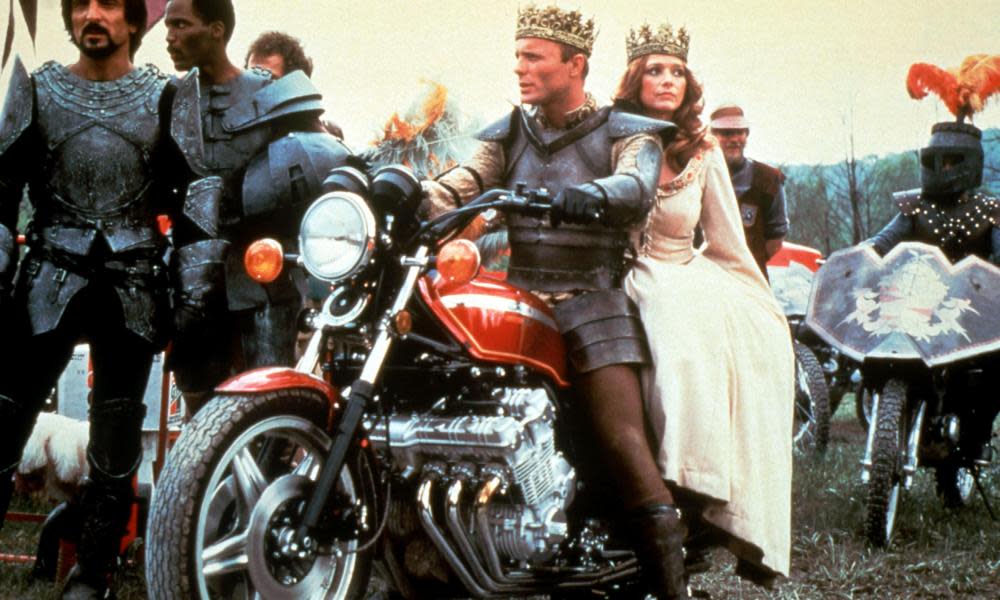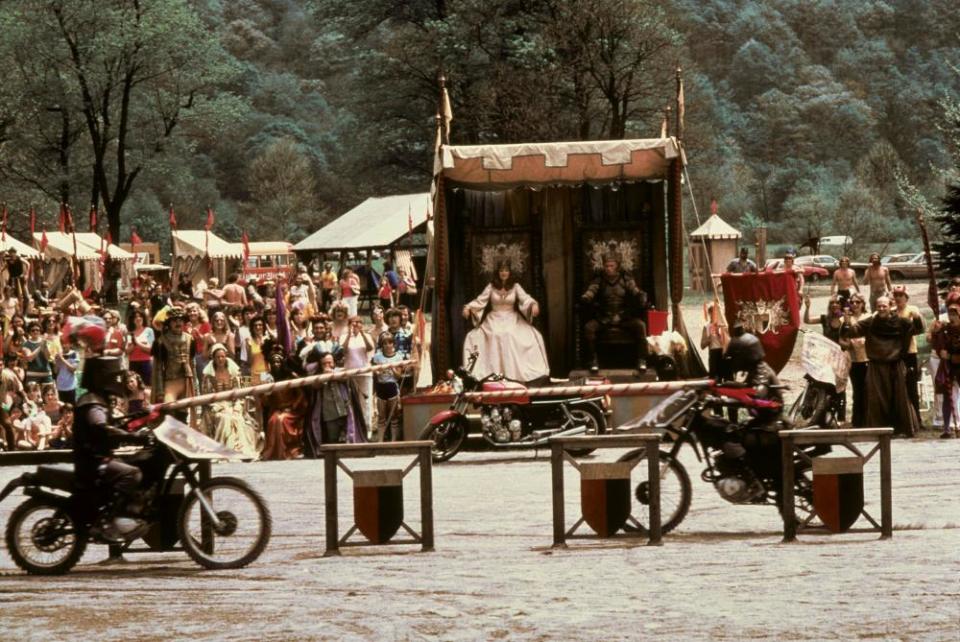Knightriders: young Ed Harris leads an outcast kingdom of role-playing medieval bikers

With golden hair catching the light, a young Ed Harris rises with a lithe damsel from a bed of ferns. He flagellates himself in a river before kneeling in prayer, naked, grasping the hilt of a mighty broadsword. Now, clothed in an impressive suit of armour, Harris mounts his trusty steed. The beast growls to life, its engine rumbles and its two wheels spin – hang on a minute, they didn’t have motorbikes in the middle ages. And is that Stephen King in a trucker hat, heckling from the front row, while eating a giant sandwich?
Harris is playing Billy, the “King” of a troupe of petrol-head LARPing (that’s live action role-playing) enthusiasts, in George A Romero’s Knightriders – the 1981 follow-up to the director’s genius, zombie-filled social satire, Dawn of the Dead. Billy’s Camelot makes money by moving town to town, performing stunt shows and selling handmade crafts. But his kingdom isn’t just about playing dress-ups; he wants to create a new society for the drifters, lost souls and people the world leaves behind.
Related: The Mummy: Brendan Fraser and Rachel Weisz’s adventurous romp catches lightning in an urn
The set up is outrageous, but Romero’s sprawling, overlooked film is really a loving, complicated examination of the difficulties of living a life at odds with the status quo. It shows how communities existing on society’s fringes, like artists and performers, are often at the forefront of creating a better and more equitable future; and are a haven for people the world at large has failed to make space for.
Knightriders doesn’t punch down and avoids stereotyping its cast of outsiders. The troupe’s town crier Pippin is queer but not camp; its mechanic Angie might be a grease monkey, but isn’t painted as a butch tomboy; and its hyper-masculine heroes are often sensitive or flawed.
The only caricatures in the film exist outside Billy’s kingdom: hangers on, neo-Nazis and corrupt sheriffs; or the sleazy manager and condescending TV executive who see the troupe as a kind of freak show to be put on display, ridiculed and profited from. They either fail to understand or simply don’t care about Billy’s noble mission. It’s a position many artists find themselves in. Kept at arm’s length by society for their otherness, while simultaneously exploited for their talents.

Knightriders excels at showing how people that choose an artistic life often do so out of compulsion, as a necessity of existence. Which isn’t to say creative people don’t wish for success or value their work, but they often can’t fight the need to create in the same way a plumber can resist laying pipes for free (no diss to plumbers here). It’s not as simple as clocking on and clocking off. When your emotions and dreams are the materials of your work, it can be hard to separate labour from life. Art and commerce are uneasy bedfellows.
At one point, Knightriders’ troupe splits as some members become frustrated with Billy’s relentless code of ethics, and follow the lure of fame. Meanwhile Billy refuses to relent – growing increasingly isolated and mad in the process – and hurts both himself and the people who care for him. The work of people like Billy may create joy, but it’s nonetheless a deeply serious undertaking in which compromise can seem impossible – and for which they’re willing to put their own bodies on the line.
Related: The Wicker Man: 1973 folk-horror endures to this day as a masterpiece of the form
During one scene, the audience dances and hollers on the sidelines, completely drawn into the spectacle conjured by the troupe, who battle themselves bloody in axe-wielding chariot duels. The performers are like dancers who’ve irreparably contorted their bodies to share their sublime movement with us, or the professional wrestlers who’ve pumped themselves full of steroids to carry us to the top of Mount Olympus.
Many artists struggle to juggle the passion, vision and ambition required to conceive previously unknown worlds against the realities of the real one in which we live. Knightriders is a reminder that for the people and communities who create the things that make life worth living, the imaginary worlds they let us inhabit momentarily are often, for them, very much real. But if we give them enough support, their utopias can permanently alter our reality too.


